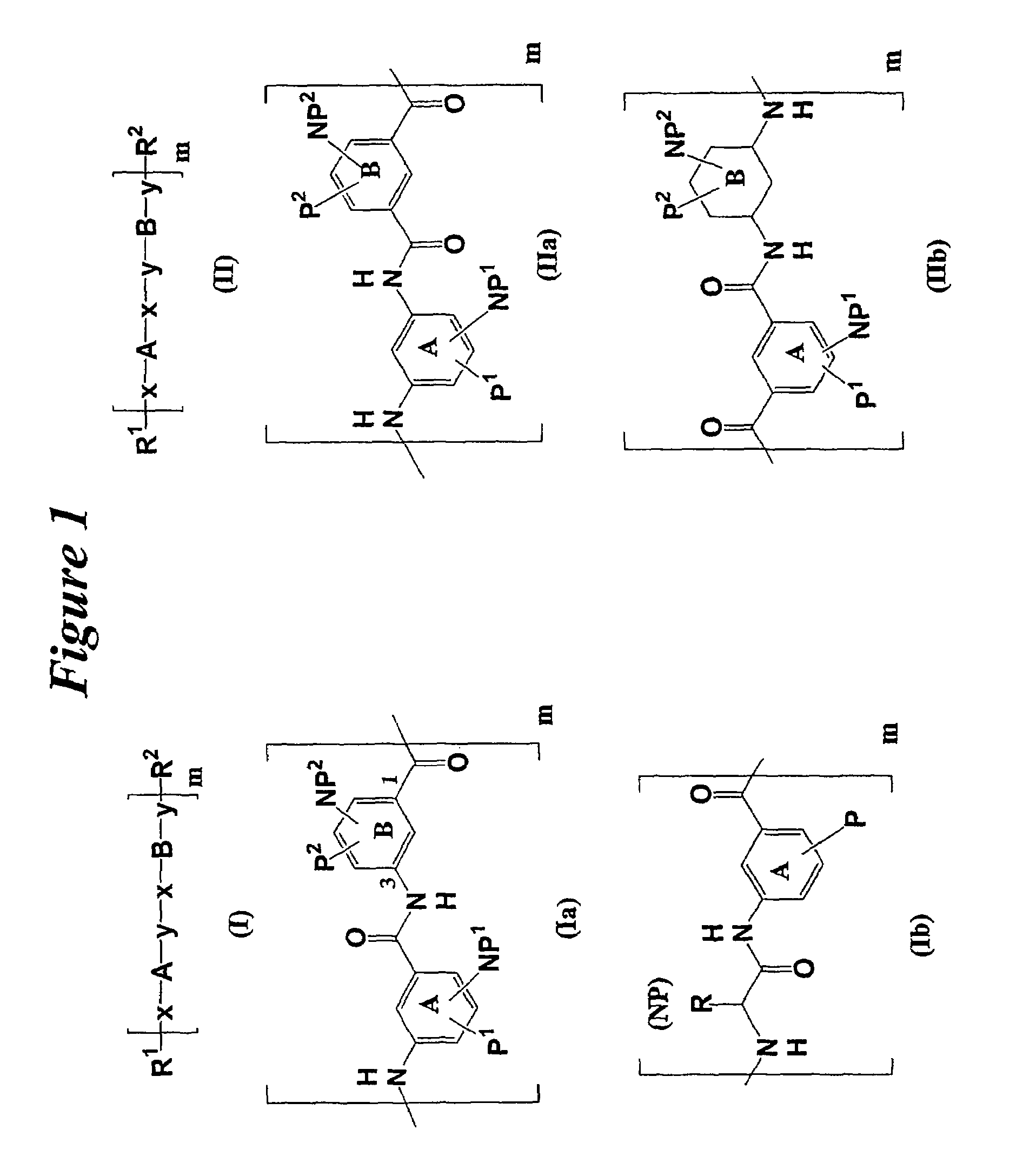Facially amphiphilic polymers as anti-infective agents
a technology of amphiphilic polymers and anti-infective agents, which is applied in the direction of antibacterial agents, optical components, sheets, etc., can solve the problems of not reporting biological properties of these compounds, and the vast majority of peptides not being available for binding to cells, mammalian cells, etc., and achieves a substantial molecular weight range
- Summary
- Abstract
- Description
- Claims
- Application Information
AI Technical Summary
Benefits of technology
Problems solved by technology
Method used
Image
Examples
example 1
Polyamide FIG. 6 XIa
2,6-Dinitro-4-t-butyl-phenyl (4-methyl)-benzenesulfonate (11)
[0292]2,6-dinitro-4-t-butyl-phenol (80 mmol; 10) and tosyl chloride (80 mmol) were dissolved in 300 ml CH2Cl2. Diisopropylethylamine (DIEA, 80 mmol) was added to the solution. The mixture was stirred at room temperature for 2 hours. The solution was washed with 10% citric acid, saturated aqueous NaCl (sat. NaCl), and dried with MgSO4. The solvent was removed under reduced pressure, and the product was obtained as a bright yellow solid in quantitative yield. 1H NMR (500 MHz, CDCl3): δ=8.12 (s, 2H), 7.80 (d, 2H), 7.40 (d, 2H), 2.51(s, 3H), 1.41 (s, 9H). ESI-MS: m / z: 417.2 (M+Na+).
2,6-Dinitro-4-t-butyl-1-(2-t-butoxycarbonylaminoethyl)-sulfanylbenzene (12).
[0293]Compound 11 (13 mmol), 2-Boc-aminoethanthiol (16 mmol) and DIEA(13 mmol) were dissolved in 50 ml chloroform. The solution was stirred under nitrogen for 12 hours. The solution was washed with 0.5 M NaOH, 10% citric acid, sat. Na2CO3 and sat. NaCl, a...
example 2
Solid Phase Synthesis of Oligomers XIb and XIc (FIG. 6)
[0296]Fmoc-PAL-PEG-resin (0.1 mmol) was swelled in DMF; then the Fmoc was removed with 20% piperidine in DMF for 20 min. The oligomer was then built up by alternately coupling 10 equivalents of isophthalic acid or diamine 10. In each case the couplings were carried out in DMF using 10 equivalents each of 2-(1H-benzotriazole-1-yl)-1,1,3,3,-tetramethyluronium hexafluorophosphate (HBTU) and N-hydroxybenzotriazole hydrate (HOBt), and 20 equivalents of DIEA for 24 hours at room temperature. The oligomers were cleaved from the resin by treatment with TFA / anisole (95:5) for 1 hour. Pure oligomers were obtained by HPLC on a reverse phase C4 column, with a linear gradient from 30% to 80% solvent B in 50 minutes (solvent A, 0.1% TFA in water; solvent B, acetonitrile / water / TFA 900:99:1). MALDI-TOF MS: XIb: 756.5 (M+H+), XIc: 1125.6.(M+H+).
example 3
General Method for Amide Polymerization
[0297]An oven-dried flask is charged with diamine dissolved in dimethylsulfoxide (DMSO). To this solution is added an equimolar quantity of the diacid chloride which is freshly prepared by stirring the dicarboxylic acid with excess thionyl chloride for 2 hr prior to addition to the diamine solution. A catalytic amount of 4-dimethylaminopyridine and four-fold molar excess of triethylamine are added to the stirring mixture. The reaction is stirred at room temperature overnight under positive N2 pressure. The DMSO solution is poured into water and the solid polymer is recovered by filtration. The degree of polymerization is controlled by the addition of various molar amounts of a monofunctional amine. The molar amount of the monofunctional amine is determined by the Flory equation (G. Odian, Principles of Polymerization, John Wiley & Sons, Third Edition (1991) p.78–82).
PUM
| Property | Measurement | Unit |
|---|---|---|
| Amphiphilic | aaaaa | aaaaa |
| Polarity | aaaaa | aaaaa |
Abstract
Description
Claims
Application Information
 Login to View More
Login to View More - R&D
- Intellectual Property
- Life Sciences
- Materials
- Tech Scout
- Unparalleled Data Quality
- Higher Quality Content
- 60% Fewer Hallucinations
Browse by: Latest US Patents, China's latest patents, Technical Efficacy Thesaurus, Application Domain, Technology Topic, Popular Technical Reports.
© 2025 PatSnap. All rights reserved.Legal|Privacy policy|Modern Slavery Act Transparency Statement|Sitemap|About US| Contact US: help@patsnap.com



